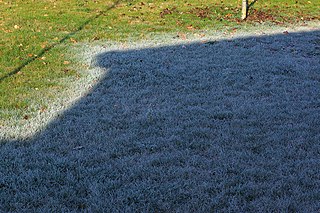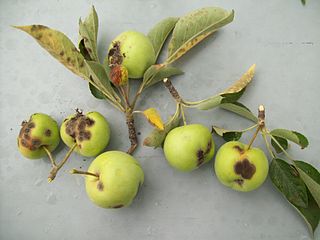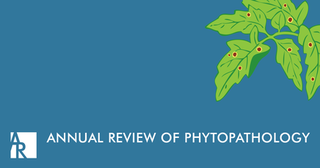Related Research Articles

Frost is a thin layer of ice on a solid surface, which forms from water vapor that deposits onto a freezing surface. Frost forms when the air contains more water vapor than it can normally hold at a specific temperature. The process is similar to the formation of dew, except it occurs below the freezing point of water typically without crossing through a liquid state.

Genetic engineering, also called genetic modification or genetic manipulation, is the modification and manipulation of an organism's genes using technology. It is a set of technologies used to change the genetic makeup of cells, including the transfer of genes within and across species boundaries to produce improved or novel organisms. New DNA is obtained by either isolating and copying the genetic material of interest using recombinant DNA methods or by artificially synthesising the DNA. A construct is usually created and used to insert this DNA into the host organism. The first recombinant DNA molecule was made by Paul Berg in 1972 by combining DNA from the monkey virus SV40 with the lambda virus. As well as inserting genes, the process can be used to remove, or "knock out", genes. The new DNA can be inserted randomly, or targeted to a specific part of the genome.

Plant pathology is the scientific study of diseases in plants caused by pathogens and environmental conditions. Organisms that cause infectious disease include fungi, oomycetes, bacteria, viruses, viroids, virus-like organisms, phytoplasmas, protozoa, nematodes and parasitic plants. Not included are ectoparasites like insects, mites, vertebrate, or other pests that affect plant health by eating plant tissues and causing injury that may admit plant pathogens. Plant pathology also involves the study of pathogen identification, disease etiology, disease cycles, economic impact, plant disease epidemiology, plant disease resistance, how plant diseases affect humans and animals, pathosystem genetics, and management of plant diseases.

Apple scab is a common disease of plants in the rose family (Rosaceae) that is caused by the ascomycete fungus Venturia inaequalis. While this disease affects several plant genera, including Sorbus, Cotoneaster, and Pyrus, it is most commonly associated with the infection of Malus trees, including species of flowering crabapple, as well as cultivated apple. The first symptoms of this disease are found in the foliage, blossoms, and developing fruits of affected trees, which develop dark, irregularly-shaped lesions upon infection. Although apple scab rarely kills its host, infection typically leads to fruit deformation and premature leaf and fruit drop, which enhance the susceptibility of the host plant to abiotic stress and secondary infection. The reduction of fruit quality and yield may result in crop losses of up to 70%, posing a significant threat to the profitability of apple producers. To reduce scab-related yield losses, growers often combine preventive practices, including sanitation and resistance breeding, with reactive measures, such as targeted fungicide or biocontrol treatments, to prevent the incidence and spread of apple scab in their crops.

Papaya ringspot virus (PRSV) is a pathogenic plant virus in the genus Potyvirus and the virus family Potyviridae which primarily infects the papaya tree.
Ice-minus bacteria is a common name given to a variant of the common bacterium Pseudomonas syringae. This strain of P. syringae lacks the ability to produce a certain surface protein, usually found on wild-type P. syringae. The "ice-plus" protein found on the outer bacterial cell wall acts as the nucleating centers for ice crystals. This facilitates ice formation, hence the designation "ice-plus". The ice-minus variant of P. syringae is a mutant, lacking the gene responsible for ice-nucleating surface protein production. This lack of surface protein provides a less favorable environment for ice formation. Both strains of P. syringae occur naturally, but recombinant DNA technology has allowed for the synthetic removal or alteration of specific genes, enabling the ice-minus strain to be created from the ice-plus strain in the lab.

Pseudomonas syringae is a rod-shaped, Gram-negative bacterium with polar flagella. As a plant pathogen, it can infect a wide range of species, and exists as over 50 different pathovars, all of which are available to researchers from international culture collections such as the NCPPB, ICMP, and others.

The American Phytopathological Society (APS) is an international scientific organization devoted to the study of plant diseases (phytopathology). APS promotes the advancement of modern concepts in the science of plant pathology and in plant health management in agricultural, urban and forest settings.
Bioprecipitation is the concept of rain-making bacteria and was proposed by David Sands from Montana State University in the 1970s. The formation of ice in clouds is required for snow and most rainfall. Dust and soot particles can serve as ice nuclei, but biological ice nuclei are capable of catalyzing freezing at much warmer temperatures. The ice-nucleating bacteria currently known are mostly plant pathogens. Recent research suggests that bacteria may be present in clouds as part of an evolved process of dispersal.

The Annual Review of Phytopathology is a peer-reviewed academic journal that publishes review articles about phytopathology, the study of diseases that affect plants. It was first published in 1963 as the result of a collaboration between the American Phytopathological Society and the nonprofit publisher Annual Reviews. As of 2023, Journal Citation Reports lists the journal's 2022 impact factor as 10.2, ranking it ninth of 238 journal titles in the category "Plant Sciences". As of 2023, it is being published as open access, under the Subscribe to Open model. Its current editors are John M. McDowell and Gwyn A. Beattie.
Robert Delafield Rands (1890–1970) was an American agronomist and mycologist. He served as chief director of Agriculture Office of Rubber Plant Investigations in the United States Department of Agriculture.

Genetic engineering is the science of manipulating genetic material of an organism. The first artificial genetic modification accomplished using biotechnology was transgenesis, the process of transferring genes from one organism to another, first accomplished by Herbert Boyer and Stanley Cohen in 1973. It was the result of a series of advancements in techniques that allowed the direct modification of the genome. Important advances included the discovery of restriction enzymes and DNA ligases, the ability to design plasmids and technologies like polymerase chain reaction and sequencing. Transformation of the DNA into a host organism was accomplished with the invention of biolistics, Agrobacterium-mediated recombination and microinjection. The first genetically modified animal was a mouse created in 1974 by Rudolf Jaenisch. In 1976 the technology was commercialised, with the advent of genetically modified bacteria that produced somatostatin, followed by insulin in 1978. In 1983 an antibiotic resistant gene was inserted into tobacco, leading to the first genetically engineered plant. Advances followed that allowed scientists to manipulate and add genes to a variety of different organisms and induce a range of different effects. Plants were first commercialized with virus resistant tobacco released in China in 1992. The first genetically modified food was the Flavr Savr tomato marketed in 1994. By 2010, 29 countries had planted commercialized biotech crops. In 2000 a paper published in Science introduced golden rice, the first food developed with increased nutrient value.

Noel Thomas Keen was an American plant physiologist. He spent his career teaching at University of California, Riverside (UCR). His research focused on the varied ability of cultivars to detect and resist pathogens.

Sophien Kamoun is a Tunisian biologist. He is a senior scientist at the Sainsbury Laboratory and professor of biology at the University of East Anglia (UEA). Kamoun is known for contributions to our understanding of plant diseases and plant immunity.

Tsune Kosuge was an American plant pathologist and plant biochemist who researched plant–microbe interactions. He was particularly known for his work on bacterial-synthesized plant hormones in plant tumors. He was a professor in the department of plant pathology at the University of California, Davis, from 1971 until his death, serving as departmental chair (1974–80).

Mortimer Paul Starr was an American microbiologist. After graduating with a PhD at Cornell, he briefly taught at Brooklyn College before accepting a position at University of California, Davis, where he stayed for thirty-seven years. He was considered an expert on plant pathology, particularly in plant diseases caused by bacteria.
Raymond Gerald Grogan was an American phytopathologist. During his career at the University of California, Davis, he primarily researched diseases that affected crops like lettuce, tomatoes, and beans. He was the editor of the Annual Review of Phytopathology from 1978–1984.
Jan Elnor Leach is an American plant pathologist. She is known for her research of the molecular biology of plant pathogens, particularly those affecting rice plants. She was the co-editor of the Annual Review of Phytopathology from 2015-2022 and is a fellow of the American Association for the Advancement of Science and a member of the National Academy of Sciences.

Amy Olymbia Charkowski is an American plant pathologist and Professor of Plant Pathology at Colorado State University. She was elected Fellow of the American Association for the Advancement of Science in 2020.
Geneviève Défago is a former lecturer in phytopathology at the Institute of Plant Sciences in the discipline of phytomedicine at ETH Zurich, the Swiss Federal Institute of Technology in Zurich, Switzerland. She was the director of interuniversity and interdisciplinary projects devoted to biological control and biosafety. In 1990, she was awarded the title of Professor. She retired at the end of July 2006.
References
- 1 2 3 4 "Ruth Allen Award" (PDF). American Phytopathological Society. Retrieved 7 December 2020.
- ↑ Magagnini, Stephen. "The green gene revolution". The Sacramento Bee. Sacramento, California.
- 1 2 3 "Steven Lindow". American Phytopathological Society.
- ↑ "Scientists Test Ice-Minus Bacteria in Potato Plot". Associated Press. 29 April 1987. Retrieved 7 December 2020.
- ↑ "Jan E. Leach" (PDF). International Society for Plant Pathology. 2017. Retrieved 7 December 2020.
- ↑ "William O. Baker Award for Initiatives in Research". National Academy of Sciences. Retrieved 7 December 2020.
- ↑ "Steven Lindow". National Academy of Sciences. Retrieved 4 December 2020.